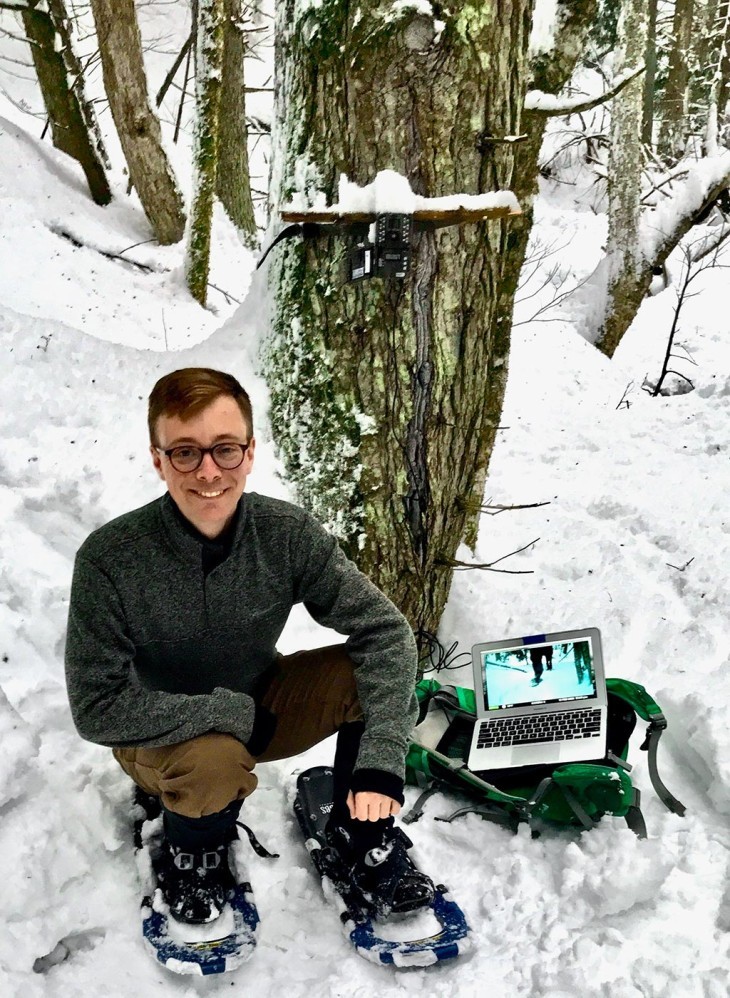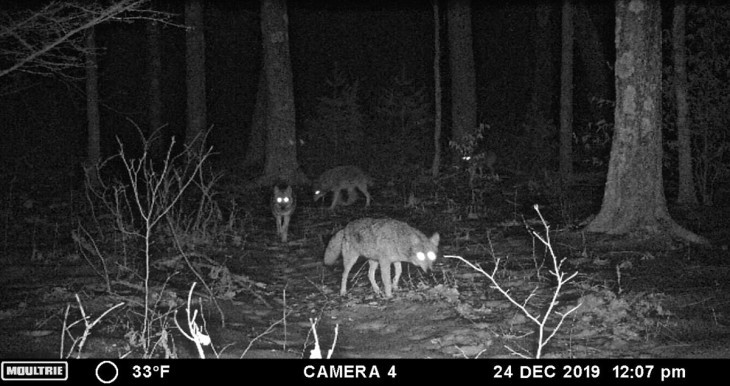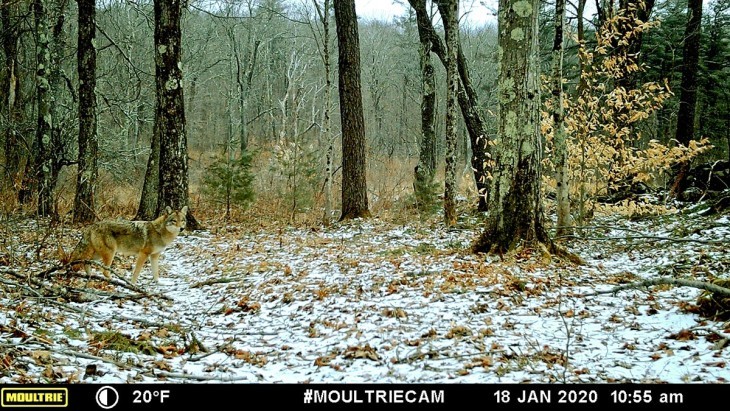Joshua Morse has spent the better part of the last decade studying the outdoors, the environment, and some of the things that live in the woods. With a bachelor’s degree in biology and a master’s in environmental science, Morse is currently a PhD candidate at the University of Vermont’s Rubenstein School of Environment and Natural Resources, where his research focuses on eastern coyotes – and our widely-varying human perception of this common wild canine. His Coyote Stories project is funded in part by an Early Career grant from the National Geographic Society, which offers individuals who are just getting started in their fields an opportunity to lead a project. The Society awards grants to individuals working in the fields of conservation, education, research, storytelling, and technology. Joshua's work combines environmental science and social science, and he’s collaborating with high school students around Vermont to gather data.
I grew up in Massachusetts and spent lots of time in the western part of the state. Behind my great grandmother’s house in Berkshire County, there is a patchwork of conservation easements and state forest land covering several thousand acres that I grew up exploring. A first-order stream that gushes down through this steep hemlock ravine there enchanted me from a very young age. I spent a lot of time chasing its tiny brook trout as a child, and I still visit that spot a few times a year as an adult. I also had my first encounter with an eastern coyote in that landscape.
One of my favorite places is the Berkshire Natural Resources Council’s Steepletop Reserve in New Marlborough, Massachusetts. Its varied woods are a joy to hike in, to hunt in, to bird in, and even just to know they are out there when I’m stuck at a desk. I’ve also been lucky to spend time in the Cold Hollow region of northern Vermont, connecting with landowners and placing wildlife cameras for Coyote Stories. It’s a wild-feeling place, full of people with fascinating stories.
There are a few things I bring with me in the woods. In the spring, the pocket-sized Sibley Field Guide to Birds of Eastern North America and a pair of binoculars. I’m also lucky to have a very well-behaved dog as a hiking buddy. Pepper does not come on every trip to the woods, since dogs are not appropriate for every forest excursion! But when she does, I find that my experience is so enriched. The things that Pepper notices—but that I would not—are incredible. When we are out walking together, she’ll lead me right to scent marking spots used by wildlife—lonely little stumps or exposed rocks on an otherwise unremarkable patch of forest floor.
I have loved the New England woods for as long as I can remember. But as I have grown up, the nature of that relationship has changed. I started out exploring the woods as a kid with a single-minded interest in fishing. But then I became a really passionate birder in college, and I took up hunting just a few years ago. Getting to learn and be shaped by, and then re-learn and find myself re-shaped by, the same landscape through these different lenses has been profound.
Over time, another element of my connection with the outdoors—and specifically the New England woods—that has become important in my work is a sense of reciprocity. I’m increasingly aware that I have this landscape to thank for an extremely interesting academic and professional path. I picked Vermont and its coyotes for my PhD in part because I wanted to do research that would hopefully return something to the New England woods, its wildlife, and its people. That desire to give back is where my interest in merging research with community engagement and environmental education comes from.
In Vermont, eastern coyotes are getting a lot of attention from interest groups who have really different visions about how the species should be managed. As a social scientist, I want to understand why people have such strong, and such varied, attitudes about coyotes in the first place. So, this project tries to gather Vermonters’ stories about coyotes as a dataset to search for clues about what values might be at play. I also recognize that stories are really valuable to the communities that produce them.
Coyote Stories is a hybrid project – kind of like the eastern coyote (Canis latrans var), which is a hybrid of the pure coyotes common out west (Canis latrans) and the Great Lakes wolf (Canis lupus lycaon). I’m interested both in learning about people’s wildlife values, and in gathering that information in ways that provide skill-building experiences for high school students in the communities where I’m working.
My hope is that this citizen science approach gives high school students a chance to develop skills like conducting an interview, listening to different perspectives, and linking information from across disciplines like ecology and social science. The idea is to gather a state-wide dataset that answers research questions about peoples’ experience with coyotes for policymakers and wildlife managers, while also returning educational benefits to the communities.
One of the biggest challenges I see to the future of our northern forests is creating accessibility for diverse publics with diverse values. An extremely powerful book I read as I planned my PhD research - Dorceta Taylor’s The Rise of the American Conservation Movement - makes an ironclad case that American conservation has historically reflected the values of a very small portion of the population – specifically, wealthy, white, recreationists. In New England, the way we manage public trust land and wildlife (and our private lands as well) still largely caters to those demographics and interests. Vermont’s Director of Racial Equity, Xusana Davis, recently made a very good argument that this approach is both unjust and unwise, given expected demographic and climate-induced changes across the New England landscape. I think it is crucial that conservation research, policy, and practice more equitably serve the full range of stakeholders who have an interest in our region’s forests and wildlife, and be more attuned to the diverse values they hold.
I also see a lot of really encouraging interest in our landscapes, wildlife, and human communities by millennials and even younger generations. I see this in the high school students and undergrads I work with. I see this in family members who grew up in the region and have chosen to stay here. I see this in programs like Vermont’s EcoAmeriCorps and Massachusetts’ TerraCorps that create pathways for recent graduates to build skills and networks in conservation focused on the New England landscape. I think the challenges facing the New England woods today and in coming decades are staggering. But I also think there’s a lot of talent and passion for addressing them in the pipeline.
In all of my research, I’m hopeful that I can help give people the tools to recognize that there is much more nuance to how society values wildlife than we commonly talk about. Often, I think the conversation just ends at the economic value that activities like hunting or wildlife watching bring to (or detract from) a given community or state. I don’t think that does justice to the diversity of ways that people experience wildlife, or gives policymakers the full range of considerations needed to manage wildlife in the public trust.
I’ve been deeply impressed by how students are able to leap into viewing wildlife management as both a natural science and a social science challenge. In academia, we sometimes get stuck in very narrow silos with very limited perspectives on how to look at and solve problems. Working with high schoolers has reminded me that the larger public doesn’t necessarily share this handicap – and that makes me hopeful about our ability to tackle the multifaceted problems facing the New England woods.





Discussion *